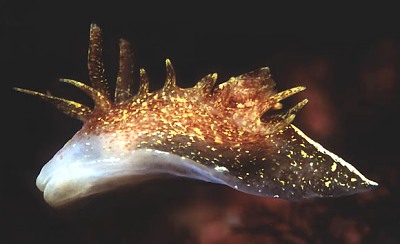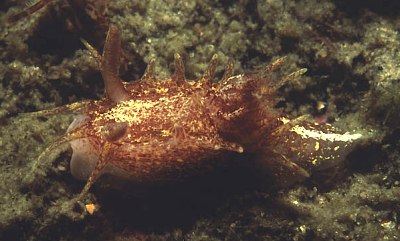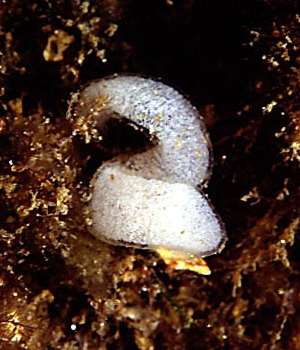

Okenia ascidicola
Morse, 1972
Order: NUDIBRANCHIA
Suborder: DORIDINA
Superfamily: ANADORIDOIDEA
Family: Goniodorididae
DISTRIBUTION
Known only from Massachusetts, USA. [Atlantic coast].
PHOTO
Gloucester, Massachusetts, USA. Photos: Alan Shepard.
The animal is translucent with a reddish brown tinge, and scattered spots and blotches of reddish brown and milky yellow all over the dorsal surface and sides of the body. The reddish brown blotches are spread rather evenly over the dorsum and sides of the body. There are also some yellow blotches scattered everywhere, but the yellow is mainly concentrated in a median line between the rhinophores and the gills and in a dorso-median line along the dorsal foot from behind the gills to the posterior tip. Sometimes the milky yellow line between the rhinophores and gills is replaced by a patch between and just behind the rhinophores.
The mantle edge bears tentacular processes. Around the head there are 4 very long processes, and down each side there are 4 much shorter ones between the rhinophores and gills. Just behind the gills, on each side, there are a pair of median sized tentacles, each pair sharing a common base. There is also a tentacular appendage in the dorsal midline just in front of the gills. There are approximately 12 bipinnate gills. The rhinophores are relatively long, and the upper half is slightly recurved backwards. There are lamellae on the underside of the upper half of each rhinophore. The animal grows to 12mm in length.
Okenia ascidicola is reported by Morse (1972), to be a specific feeder on the solitary ascidian Molgula manhattanensis. It has seldom been found, probably because of its association with its food. It eats through the tough outer skin of the ascidian and nestles in the cavity it makes, leaving only the gills protruding. It has been reported only from Massachusetts on the Atlantic coast of Nth America.
Reference:
• Morse, M.P. (1972). Biology of Okenia ascidicola spec. nov. The Veliger, 15(2): 97-101.
Rudman, W.B., 2003 (July 17) Okenia ascidicola Morse, 1972. [In] Sea Slug Forum. Australian Museum, Sydney. Available from http://www.seaslugforum.net/find/okenasci
Related messages
Eggs of Okenia ascidicola
December 16, 2003
From: Alan Shepard

Bill -
When I first sent you the photographs of Okenia ascidicola I mentioned that I also had shots of their egg strings. Well I finally got around to scanning them so here you go. There were dozens of egg strings at the time all attached to the substrate in an area covered with Molgula manhattensis, O. ascidicola's food source.
Finding the egg strings of various nudibranchs is sometimes the easiest way to know that there is a nudibranch about.
Best wishes,
Alan Shepard
Tolland, CT, USA
alan.chepard@snet.net
Shepard, A., 2003 (Dec 16) Eggs of Okenia ascidicola. [Message in] Sea Slug Forum. Australian Museum, Sydney. Available from http://www.seaslugforum.net/find/11689Thanks Alan,
Egg ribbons are certainly a good indication that a nudibranch is hiding nearby. It seems to be a flaw in most nudibranchs' defensive strategy, but I guess humans are the only 'predators' who have the brain power to realise that the presence of egg ribbons means that there is a good chance that the 'egg ribbon maker' is near by.
Best wishes
Bill Rudman
Okenia ascidicola from Gloucester, Massachusetts, USA
July 19, 2003
From: Alan Shepard


Bill,
Here's a shot of what I believe is Okenia ascidicola from Gloucester, Massachusetts, USA. It seems to fit the description of the species as described in Bleakney's book, Sea Slugs of Atlantic Canada and the Gulf of Maine quite well. The text indicates that all previous specimens have come from the Nahant area of Massachusetts, USA.
According to Bleakney it feeds upon Molgula manhattensis, an ascidian, hence the name. When it is feeding it bores its way in to the ascidian to feed on the softer insides and only its gills project through the hole. M. manhattensis is pretty nondescript and usually covered with sand and other debris so it is often overlooked. I was very lucky to actually find O. ascidicola.
I was exploring a large boulder at a depth of about 6 meters or so when I saw some eggs that I knew I had never seen before (I do have some so-so shots of the eggs). I looked about for the nudibranch that may have layed them and saw nothing (I did notice M. manhattensis though). I swam off a bit and then spotted a 12 millimeter nudibranch hanging by a "thread" in the current (see attached). I immediately knew it was something new to me and thought it was a species of Okenia. I gently hooked the thread it was attached to with my camera's framer and brought it down to the substrate to get the other photos I've attached.
I'm hoping you or someone else can confirm my tentative identification.
Best wishes,
Alan Shepard
Tolland, CT, USA
alan.chepard@snet.net
Shepard, A., 2003 (Jul 19) Okenia ascidicola from Gloucester, Massachusetts, USA. [Message in] Sea Slug Forum. Australian Museum, Sydney. Available from http://www.seaslugforum.net/find/10075Dear Alan,
This is an interesting find. From Patricia Morse's description I am sure you have correctly identified this rarely reported species. The habit of living in a burrow it has eaten in its prey ascidian is very reminiscent of Goniodoris meracula in southeastern Australia.
Best wishes,
Bill Rudman
